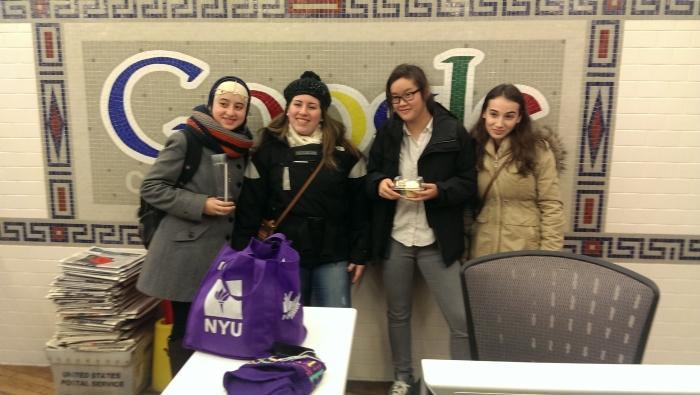Academy of Information Technology (IT)
James Madison High School’s Academy of Information Technology is a member of NAF, a national network of education, business, and community leaders who work together to ensure high school students are college, career, and future ready. Since 1982, NAF has been partnering with existing high schools in high-needs communities to enhance school systems at a low cost by implementing NAF academies – small learning communities within traditional high schools. NAF has grown from one NAF Academy of Finance in New York City to hundreds of academies across the country focusing on growing industries including: finance, hospitality & tourism, information technology, engineering, and health sciences. NAF’s educational design ignites students’ passion for learning and gives businesses the opportunity to shape America’s future workforce by transforming the learning environment to include STEM infused industry-specific curricula and work-based learning experiences, including internships.
Course of Study:
Year 1
Principles of IT (Fall Semester)
Robotics (Spring Semester)
Robotics (Spring Semester)
Year 2
Intro to CS: Python I (Fall Semester)
Intro to CS: Python II (Spring Semester)
Intro to CS: Python II (Spring Semester)
Year 3
Programming in Java I (Fall Semester)
Programming in Java II (Spring Semester)
Programming in Java II (Spring Semester)
Year 4
AP Computer Science A (Fall and Spring Semester)
Activities:
In addition to studying career-focused curriculum and working on collaborative projects, IT students gain critical career knowledge through a series of work-based learning experiences both inside and outside of the classroom. These activities include job shadowing, mock interviews, resume writing workshops, and culminate with a compensated internship.
In the past two years, Madison students have
In the past two years, Madison students have
- Spent a day shadowing professionals at Ernst & Young, CPA firms, and NAF, the parent organization of the Academy of Information Technology.
- Attended trips to the American Management Association, and NYU.
- Participated in NY Exploring’s after school workshops held at Credit Suisse, Citi Personal Wealth Management and local area hospitals. Students toured facilities, had their questions answered by human resources, networked with managers and more!
- Achieved Microsoft Office certification in Word, PowerPoint and Excel.
Internships:
The internship experience gives students a chance to gain real world, hands-on experience, make lasting professional connections, and discover more about their interest and proficiency along a specific career path. Internship experiences are linked to students’ future career goals in order to make learning more engaging and relevant. The business partners who hire Academy students as interns benefit from the efforts of enthusiastic, prepared, and highly conscientious workers and get the chance to train and recruit future employees.
Students have the opportunity to apply for a paid 6-week internship the summer after the junior year. In the past few years, Madison IT students have had internships at Verizon, Fitch Ratings, Town Hall and TinyBop.
Students have the opportunity to apply for a paid 6-week internship the summer after the junior year. In the past few years, Madison IT students have had internships at Verizon, Fitch Ratings, Town Hall and TinyBop.
Who can apply to I.T. House?
Students may apply to the Academy of I.T. as incoming freshmen by applying to Madison through the zone. Once selected for Madison, all students will fill out a house selection sheet where they will rank houses. Sophomores/juniors wishing to transfer from another house may request to join the I.T. program, provided there is space in the program. Students should:
- Possess strong analytical and mathematical skills.
- Demonstrate mastery of math and science by earning grades of 85% or higher in all courses.
- Desire to learn mathematics, science and computer science in-depth.
COURSE DESCRIPTIONS
Principles of Information Technology: This is the first course students take in the Academy of Information Technology. It provides an overview of information technology and introduces students to the basics of hardware and software. Students examine hardware components including peripherals, connectors, and memory. Students explore common operating systems, software applications, and programming languages. Students also consider contemporary issues such as security, privacy, and technological inequality. Finally, students explore career opportunities in IT.Robotics: Students research dynamics, kinematics and sensors. Subjects such as motion planning and obstacle avoidance, velocity and acceleration, serial chain mechanisms, pneumatic actuators, and drive circuits are covered. Students put knowledge into practice through lab settings where robots are created with teams.
Python: This course introduces students to Python, one of the most popular, and in-demand programming languages, great for beginner developers. Students will learn the basics of computer programming along with the basics of computer science. The material emphasizes computational thinking and helps develop the ability to solve complex problems. Students will explore graphics and learn about how computer science is used in the entertainment industry.
Java: This course provides students with a basic foundation in Java syntax. Students will learn how computers make decisions and how Java keeps track of information through variables and data types. They will learn to create conditional statements, methods, and loops to process information and solve problems.
Java: This course provides students with a basic foundation in Java syntax. Students will learn how computers make decisions and how Java keeps track of information through variables and data types. They will learn to create conditional statements, methods, and loops to process information and solve problems.
AP Computer Science A: This course builds on students’ knowledge of programming and problem solving, and introduces design strategies and methodologies, organization (data structures), approaches to processing data (algorithms) , analysis of potential solutions and the ethical and social implications of computing. The course emphasizes both object-oriented and imperative problem solving and design.
To be added to sequence:
Web Design: A hands-on introduction to designing, building, and launching websites. Students learn the basics of HTML coding, explore various web development tools, and get practice creating websites using Adobe Dreamweaver. They learn how to make their websites more effective by applying the principles of design as well as usability and accessibility criteria. Finally, students take a look at various career opportunities in web design.
Cyber Security: This course prepares students with crucial skills to be responsible citizens in a digital future. Students will learn foundational cybersecurity topics including digital citizenship and cyber hygiene, the basics of cryptography, software security, networking fundamentals, and basic system administration.





